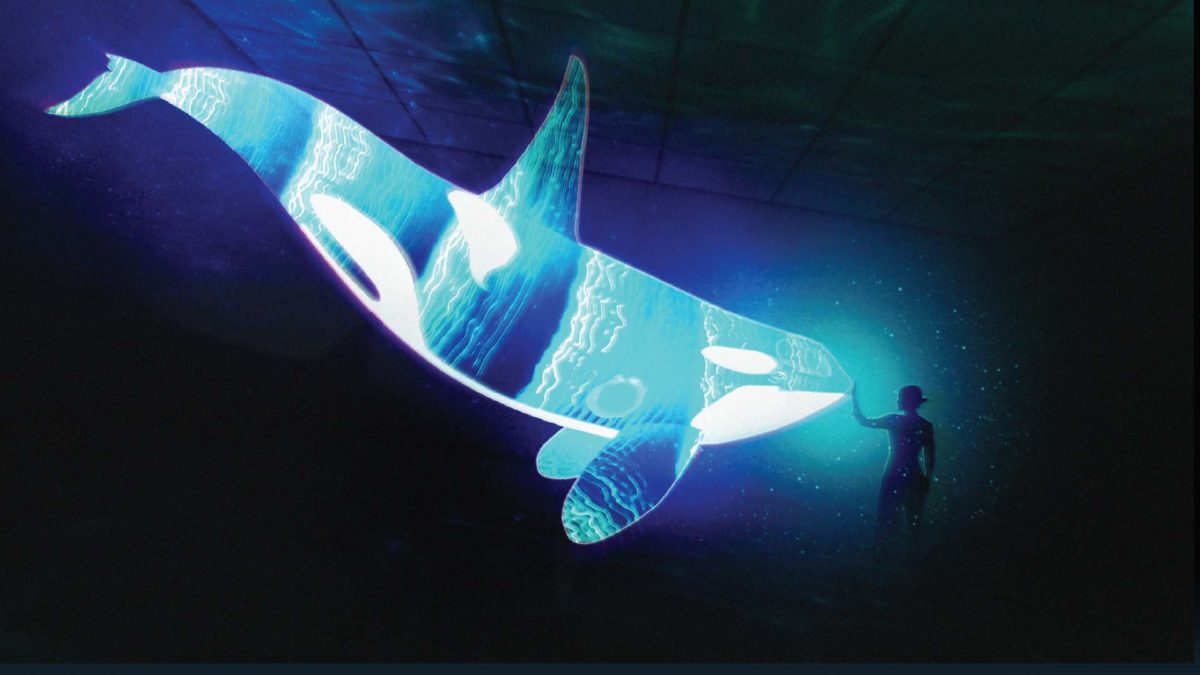Alarms about species extinction have proliferated, especially as the climate crisis accelerates. But it has been often difficult to raise general public awareness sufficiently about the effects of these dire conditions through conventional means.
The National Museum of Natural History in DC has succeeded in mitigating this awareness gap with its immersive exhibit “Critical Distance,” which presents a compelling case for rescuing the rapidly declining population of orca killer whales from extinction.
The exhibit, which was developed in cooperation with Microsoft and Vision3, LLC, “emphasizes the intrinsic connection between people, orcas, and the ocean,” explains the museum in a description. “It immerses visitors in a holographic orca pod and allows them to witness the daily obstacles of the endangered species.”
As Vision3 Director of Production Adam May notes, orcas face a number of threats. These include a scarcity of prey, due to limited numbers of chinook salmon, pollutants such as PCBs and other chemicals, and human-created aquatic noise pollution, which limits the ability of the orcas to hunt and communicate.
The exhibit highlights the impact of the sharp drop in orca whales on the life and livelihood of the Salish people, which has centered around fishing the whales. The Salish people are indigenous people living in the Pacific Northwest of the US and the Southwest of Canada. As such, the exhibit gives visitors a sense of the urgency and magnitude of the problem.
The actual immersive experience, which uses Microsoft’s AR hololens technology, runs nine minutes long, and the whole process, from start to finish, including an introduction, runs 15 minutes long, reports Mike Lawrence, assistant director for exhibits at the National Museum of Natural History. It’s geared to visitors ages 10 and up, and has been popular with families and younger people, he said.

The projection environment from “Critical Distance” at the National Museum of Natural History. (Courtesy photo)
The exhibit evolved fortuitously and after significant exploration of the potential use of VR and mixed reality in the museum’s exhibits, explains Lawrence. Initially, the museum had concerns about key challenges of launching VR projects, including the “staff intensive” nature of those projects and the “limited throughput” they afforded, he said. At the same time, the museum realized the potential for using empty gallery space for immersive experiences.
While the leaders were in discussions with Microsoft regarding a possible partnership on AR exhibit projects, Microsoft leaders shared that they were working on the exhibit with Vision3, and wanted to test it in a public venue, according to Lawrence.
The museum’s leaders thought the experience was a perfect fit for its space.
“We had the capacity to exhibit it and ocean-based conservation is in line with our message,” Lawrence said. He added that, “installing the experience at our museum offers an opportunity to share the message with a much broader audience,” which was particularly attractive to Microsoft.
“Our launching point for ‘Critical Distance’ was exploring how we might creatively demonstrate to audiences how the orcas use Echolocation in a first person sense,” May said. “AR provided us a way to show audiences something entirely unique — and use this experience as a shared first step to build from in better understanding our role as humans in the crucial threats the Southern Residents are facing. The project is primarily about creating a lasting connection to the natural world. Through an interactive experience, as audiences witness a degree of control in how ‘Critical Distance’ is presented to them, we believe they will feel a sense of agency in the project and the issues.”

Inside the “Critical Distance” exhibit at the Natural Museum of Natural History. (Courtesy photo)
May described it as a social AR project, in which partcipants share different viewpoints of the same experience, rather than individual views at the same time.
“This is important to build a feeling of connection and collective presence,” May said. “We want to make audiences feel like they are a part of the pod, and the natural world overall. Family plays a very significant part in the survival of the Southern Residents, and it’s important that all audiences feel welcomed into this. So it became very important to be able to see the other members of the audience experiencing ‘Critical Distance’ with you, to know they also are seeing what you are, and to be able to share your reactions in real time as the story progresses.”
The National Museum of Natural History plans to evaluate visitor feedback to the exhibit in November. But, so far, it has elicited “a favorable response from visitors,” reports Lawrence. At the same time, the museum staff observed that some visitors are reluctant to spend much time waiting in line to try the immersive experience, and leave early. To address this issue, the museum plans in the future to group immersive exhibits with other activities, such as conventional exhibits.
The exhibit, which opened in September, is due to run until June 2022. If Microsoft is unable to secure other public venues for the experience, the Natural Museum of Natural History could extend the exhibit beyond that time, noted Lawrence.
Before you go...
Please consider supporting Technical.ly to keep our independent journalism strong. Unlike most business-focused media outlets, we don’t have a paywall. Instead, we count on your personal and organizational support.
Join our growing Slack community
Join 5,000 tech professionals and entrepreneurs in our community Slack today!

Entrepreneurship is changing, and so is the economic development behind it

Tech Hubs’ new $210M funding leaves Baltimore and Philly off the table

Here’s what to know before using AI to craft your brand’s social media posts


